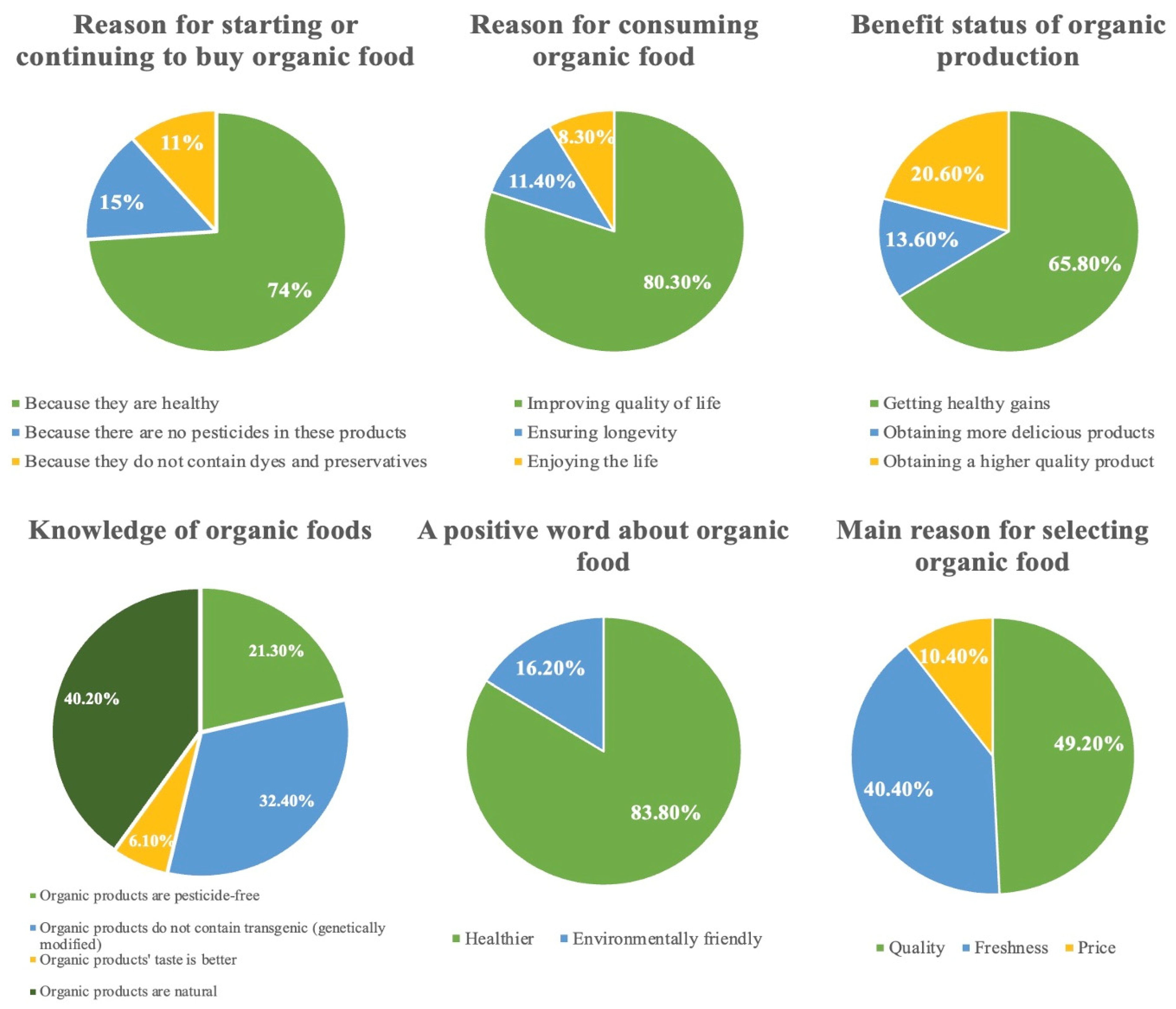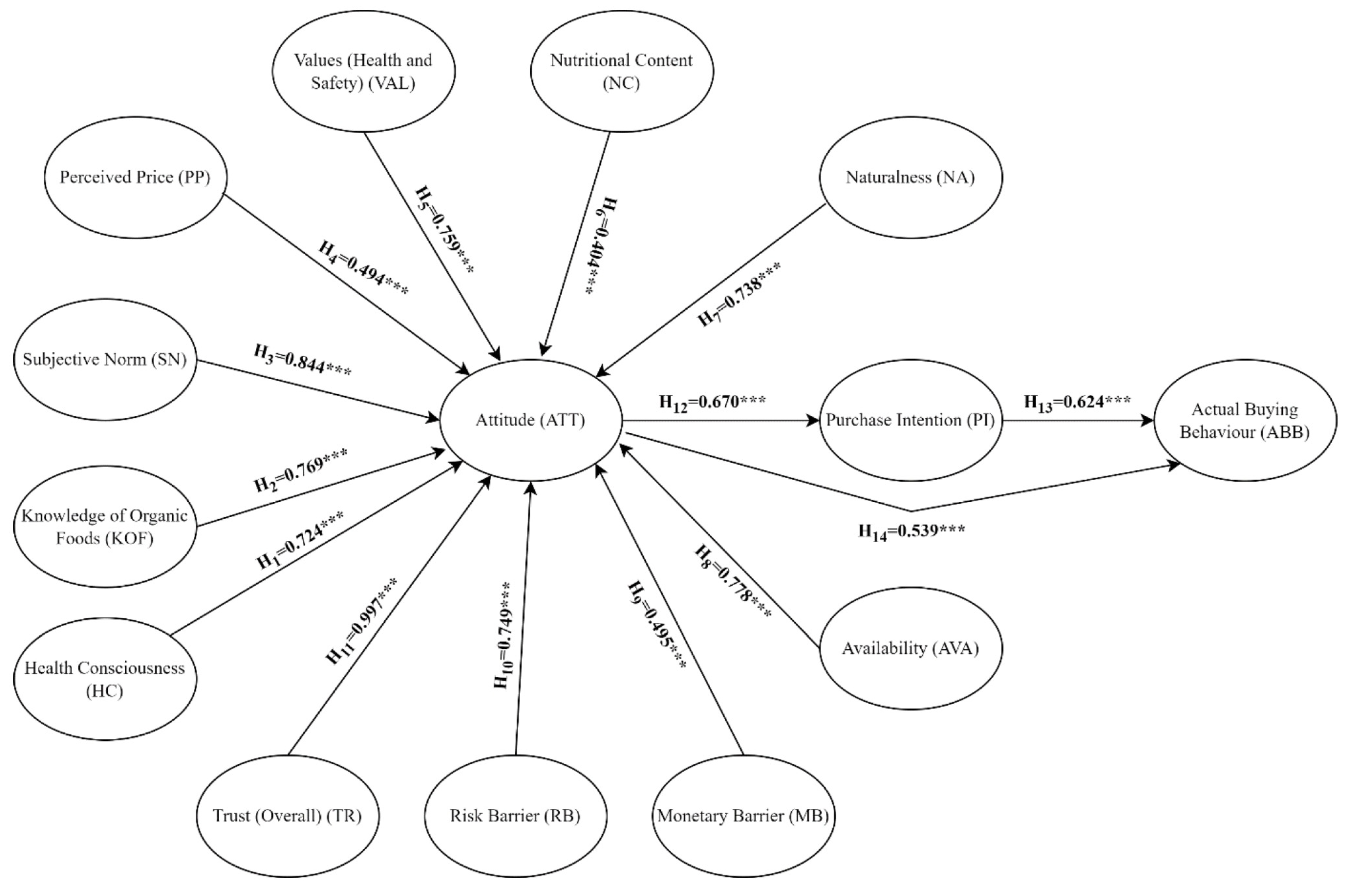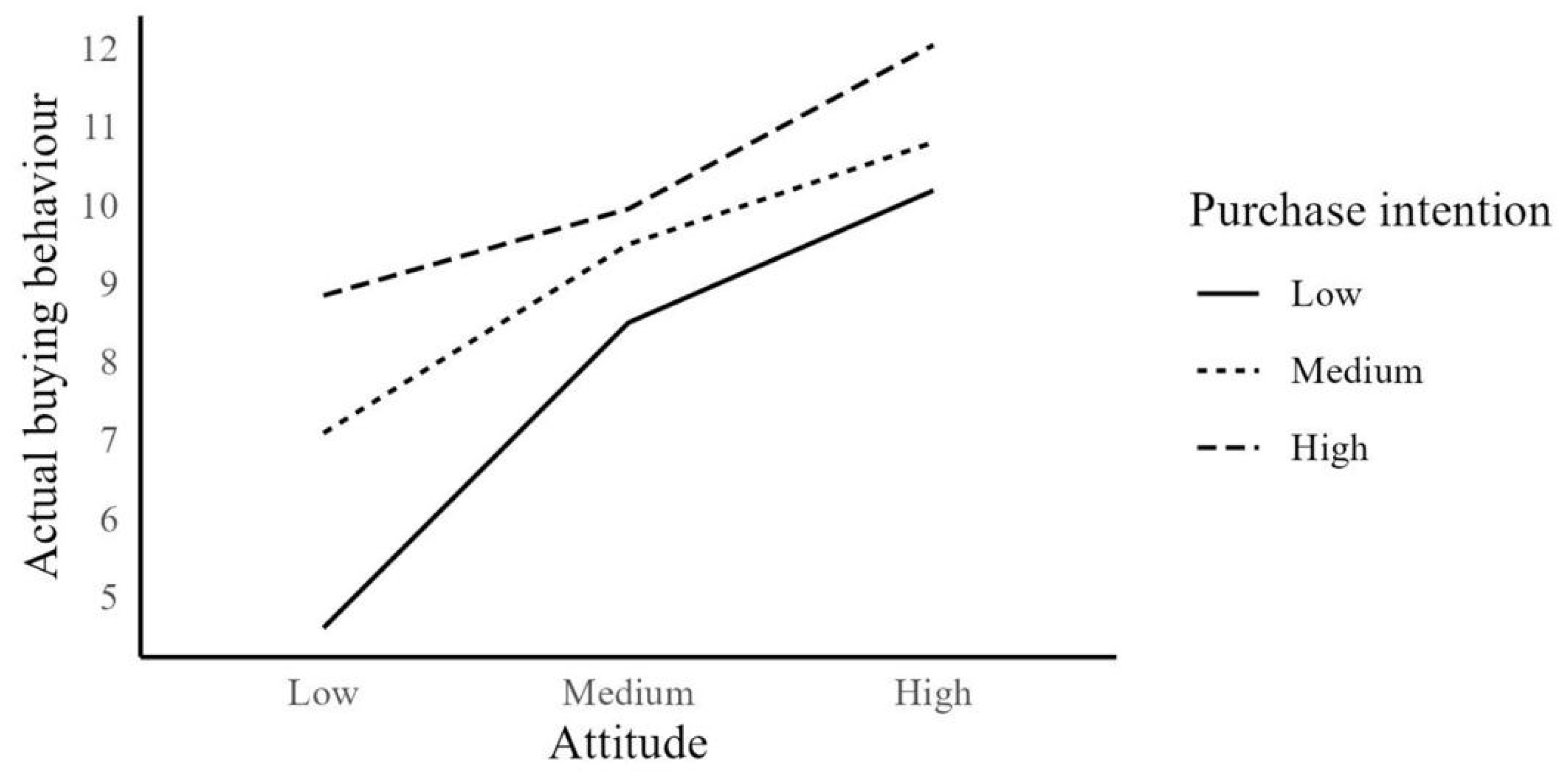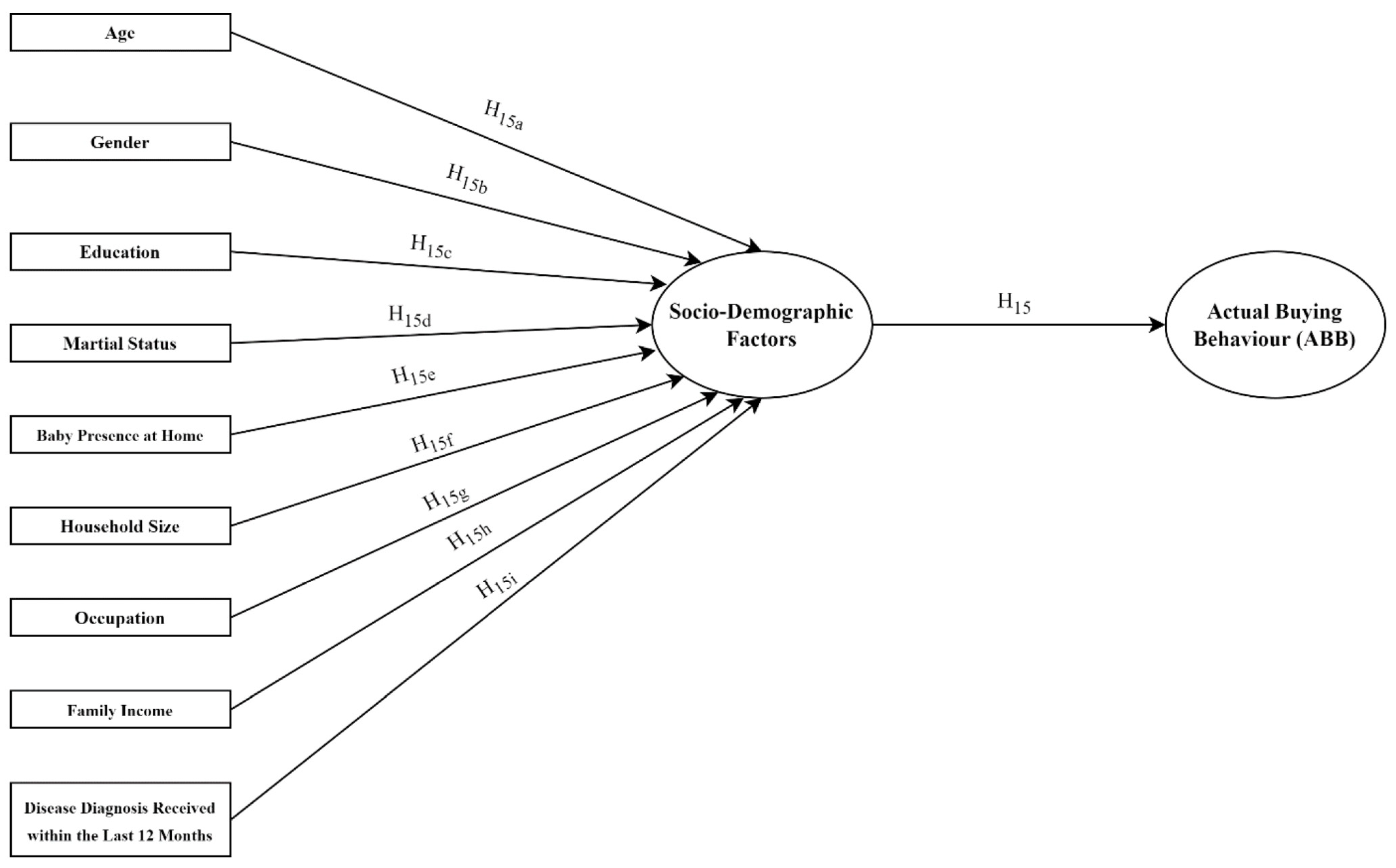Results from Türkiye: Which Factors Drive Consumers to Buy Organic Food?
Abstract
1. Introduction
1.1. Literature Review and Hypotheses
1.1.1. Health Consciousness
1.1.2. Knowledge of Organic Foods
1.1.3. Subjective Norm
1.1.4. Perceived Price
1.1.5. Values (Health and Safety)
1.1.6. Nutritional Content
1.1.7. Naturalness
1.1.8. Availability
1.1.9. Monetary Barrier
1.1.10. Risk Barrier
1.1.11. Trust (Overall)
1.1.12. Purchase Intention
1.1.13. Actual Buying Behaviour
1.1.14. Sociodemographic Factors
Age
Gender
Education
Marital Status
Having Children and Household Size
Employment Status
Income
2. Materials and Methods
2.1. Sample and Data Collection Procedure
2.2. Statistical Analysis
3. Results and Discussion
3.1. Description of the Sample
3.2. Reasons for Purchasing Organic Foods
4. Conclusions
Limitations of This Study
Supplementary Materials
Author Contributions
Funding
Institutional Review Board Statement
Informed Consent Statement
Data Availability Statement
Acknowledgments
Conflicts of Interest
References
- U.S. Department of Agriculture. Organic 101: What the USDA Organic Label Means. Available online: https://www.usda.gov/media/blog/2012/03/22/organic-101-what-usda-organic-label-means (accessed on 16 August 2023).
- Paul, J.; Rana, J. Consumer behavior and purchase intention for organic food. J. Consum. Mark. 2012, 29, 412–422. [Google Scholar] [CrossRef]
- Gomiero, T.; Pimentel, D.; Paoletti, M.G. Environmental impact of different agricultural management practices: Conventional vs. organic agriculture. Crit. Rev. Plant Sci. 2011, 30, 95–124. [Google Scholar] [CrossRef]
- Gundala, R.R.; Singh, A. What motivates consumers to buy organic foods? Results of an empirical study in the United States. PLoS ONE 2021, 16, e0257288. [Google Scholar] [CrossRef] [PubMed]
- Valoppi, F.; Agustin, M.; Abik, F.; Morais de Carvalho, D.; Sithole, J.; Bhattarai, M.; Varis, J.J.; Arzami, A.N.A.B.; Pulkkinen, E.; Mikkonen, K.S. Insight on current advances in food science and technology for feeding the world population. Front. Sustain. Food Syst. 2021, 5, 626227. [Google Scholar] [CrossRef]
- Feil, A.A.; da Silva Cyrne, C.C.; Sindelar, F.C.W.; Barden, J.E.; Dalmoro, M. Profiles of sustainable food consumption: Consumer behavior toward organic food in southern region of Brazil. J. Clean. Prod. 2020, 258, 120690. [Google Scholar] [CrossRef]
- Mie, A.; Andersen, H.R.; Gunnarsson, S.; Kahl, J.; Kesse-Guyot, E.; Rembiałkowska, E.; Quaglio, G.; Grandjean, P. Human health implications of organic food and organic agriculture: A comprehensive review. Environ. Health 2017, 16, 111. [Google Scholar] [CrossRef] [PubMed]
- Kesse-Guyot, E.; Péneau, S.; Méjean, C.; Szabo de Edelenyi, F.; Galan, P.; Hercberg, S.; Lairon, D. Profiles of organic food consumers in a large sample of French adults: Results from the Nutrinet-Sante cohort study. PLoS ONE 2013, 8, e76998. [Google Scholar] [CrossRef]
- Madureira, T.; Nunes, F.; Veiga, J.; Saralegui-Diez, P. Choices in sustainable food consumption: How Spanish low intake organic consumers behave. Agriculture 2021, 11, 1125. [Google Scholar] [CrossRef]
- Singh, A.; Verma, P. Factors influencing Indian consumers’ actual buying behaviour towards organic food products. J. Clean. Prod. 2017, 167, 473–483. [Google Scholar] [CrossRef]
- Tandon, A.; Dhir, A.; Kaur, P.; Kushwah, S.; Salo, J. Behavioral reasoning perspectives on organic food purchase. Appetite 2020, 154, 104786. [Google Scholar] [CrossRef]
- TechSci 2021. Global Organic Food Market By Product Type (Organic Meat, Poultry and Dairy; Organic Fruits and Vegetables; Organic Processed Food; Organic Bread and Bakery; Organic Beverages; Organic Processed Food and Others), By Distribution Channel Type (Hypermarket/Supermarket, Speciality Stores, Departmental Stores, Online and Others (Spices, Pulses, Cereals and Food Grain etc.), By Region, Competition, Forecast Opportunities, 2026 [2021 July]. Available online: https://www.techsciresearch.com/report/organic-food-market/4401.html (accessed on 21 August 2023).
- Vilchez, I.M. Environment and Agriculture. In Turkey in the European Union. Implications for Agriculture, Food and Structural Policy; Burrel, A.M., Oskam, A.J., Eds.; CABI Publishing: Wallingford, UK, 2005; pp. 169–191. [Google Scholar]
- Cakirli Akyüz, N.; Theuvsen, L. Organic agriculture in Turkey: Status, achievements, and shortcomings. Org. Agric. 2021, 11, 501–517. [Google Scholar] [CrossRef]
- Ministry of Agriculture and Forestry. (Updated 2022). Available online: https://www.tarimorman.gov.tr/Konular/Bitkisel-Uretim/Organik-Tarim/Istatistikler (accessed on 21 August 2023).
- Goktuna, B.O.; Hamzaoglu, M. Organic food demand in Turkey: Segmentation from necessity to variety. Org. Agric. 2023, 13, 145–171. [Google Scholar] [CrossRef]
- Eti, H.S. Organik Gıda Tüketicilerinin Belirlenmesi: Teşvik Unsurları, Güven Yönelimleri ve Satınalma Davranışı. Balk. Near East. J. Soc. Sci. 2017, 3, 89–94. [Google Scholar]
- Ozdemir, S.S. Organik gıda tüketiminin iki güdüleyicisi olarak korku ve haz: Türk tüketiciler üzerine bir araştırma. OPUS Int. J. Soc. Res. 2021, 18, 5651–5672. [Google Scholar]
- Sarıca, D.; Michael, G.D.; Ilyas, O.M.A.R. Üniversite öğrencilerinin organik gıda tüketim davranışlarını etkileyen faktörlerin ekonometrik analizi: Isparta ili örneği. J. Agric. Fac. Ege Univ. 2023, 60, 111–123. [Google Scholar] [CrossRef]
- Chinnici, G.; D’Amico, M.; Pecorino, B. A multivariate statistical analysis on the consumers of organic products. Br. Food J. 2002, 104, 187–199. [Google Scholar] [CrossRef]
- Harper, G.C.; Makatouni, A. Consumer perception of organic food production and farm animal welfare. Br. Food J. 2002, 104, 287–299. [Google Scholar] [CrossRef]
- Nguyen, N.P.T.; Dang, H.D. Organic food purchase decisions from a context-based behavioral reasoning approach. Appetite 2022, 173, 105975. [Google Scholar] [CrossRef]
- Glanz, K.; Basil, M.; Maibach, E.; Goldberg, J.; Snyder, D. Why Americans eat what they do: Taste, nutrition, cost, convenience, and weight control concerns as influences on food consumption. J. Am. Diet. Assoc. 1998, 98, 1118–1126. [Google Scholar] [CrossRef]
- Hasselbach, J.L.; Roosen, J. Consumer heterogeneity in the willingness to pay for local and organic food. J. Food Prod. Mark. 2015, 21, 608–625. [Google Scholar] [CrossRef]
- Hasselbach, J.L.; Roosen, J. Motivations behind pref- erences for local or organic food. J. Int. Consum. Mark. 2015, 27, 295–306. [Google Scholar] [CrossRef]
- Raza, S.A.; Shah, N.; Nisar, W. Consumer Buying Behavior of Organic Food with Respect to Health and Safety Concerns among Adolescents; MPRA Paper 93570; University Library of Munich: Munich, Germany, 2019. [Google Scholar]
- Hill, H.; Lynchehaun, F. Organic milk: Attitudes and consumption patterns. Br. Food J. 2002, 104, 526–542. [Google Scholar] [CrossRef]
- Kushwah, S.; Dhir, A.; Sagar, M. Understanding con-sumer resistance to the consumption of organic food. A study of ethical consumption, purchasing, and choice behaviour. Food Qual. Prefer. 2019, 77, 1–14. [Google Scholar] [CrossRef]
- Bamberg, S.; Moser, G. Twenty years after Hines, Hungerford, and Tomera: A new meta-analysis of psycho-social determinants of pro-environmental behaviour. J. Environ. Psychol. 2007, 27, 14–25. [Google Scholar] [CrossRef]
- Brucks, M. The effects of product class knowledge on information search behavior. J. Consum. Res. 1985, 12, 1–16. [Google Scholar] [CrossRef]
- Canova, L.; Bobbio, A.; Manganelli, A.M. Buying Organic Food Products: The Role of Trust in the Theory of Planned Behavior. Front. Psychol. 2020, 11, 575820. [Google Scholar] [CrossRef] [PubMed]
- Scalco, A.; Noventa, S.; Sartori, R.; Ceschi, A. Predicting organic food consumption: A meta-analytic structural equation model based on the theory of planned behavior. Appetite 2017, 112, 235–248. [Google Scholar] [CrossRef]
- Armitage, C.J.; Conner, M. Efficacy of the theory of planned behaviour: A meta-analytic review. Br. J. Soc. Psychol. 2001, 40, 471–499. [Google Scholar] [CrossRef]
- Gan, C.; Wee, H.Y.; Ozanne, L.; Kao, T.H. Consumers’ purchasing behavior towards green products in New Zealand. Innov. Mark. 2008, 4, 93–102. [Google Scholar]
- Radman, M. Consumer consumption and perception of organic products in Croatia. Br. Food J. 2005, 107, 263–273. [Google Scholar] [CrossRef]
- Smith, T.A.; Huang, C.L.; Lin, B.H. Does price or income affect organic choice? Analysis of US fresh produce users. J. Agric. Appl. Econ. 2009, 41, 731–744. [Google Scholar] [CrossRef]
- Kareklas, I.; Carlson, J.R.; Muehling, D.D. “I eat organic for my benefit and yours”: Egoistic and altruistic considerations for purchasing organic food and their implications for advertising strategists. J. Advert. 2014, 43, 18–32. [Google Scholar] [CrossRef]
- Pino, G.; Alessandro, M.P.; Gianluigi, G. Determinants of Regular and Occasional Consumers’ Intentions to Buy Organic Food. J. Consum. Aff. 2012, 46, 157–169. [Google Scholar] [CrossRef]
- Aertens, J.; Verbeke, W.; Mondelaers, K.; Van Huylenbroeck, G. Personal determinants of organic food consumption: A review. Br. Food J. 2009, 111, 1140–1167. [Google Scholar] [CrossRef]
- Ott, S.L. Supermarket shoppers’ pesticide concerns and willingness to purchase certified pesticide residue-free fresh produce. Agribusiness 1990, 6, 593–602. [Google Scholar] [CrossRef]
- Squires, L.; Juric, B.; Bettina Cornwell, T. Level of market development and intensity of organic food consumption: Cross-cultural study of Danish and New Zealand consumers. J. Consum. Mark. 2001, 18, 392–409. [Google Scholar] [CrossRef]
- Escobar-López, S.Y.; Espinoza-Ortega, A.; Vizcarra-Bordi, I.; Thomé-Ortiz, H. The consumer of food products in organic markets of central Mexico. Br. Food J. 2017, 119, 558–574. [Google Scholar] [CrossRef]
- Kampffmeyer Food Innovation Study. 2012. Available online: http://goodmillsinnovation.com/sites/kfi.%20kampffmeyer.faktor3server.de/files/attachments/1_pi_kfi_cleanlabelstudy_english_%20final.pdf/Accessed%2015.10.16 (accessed on 21 August 2023).
- Pieniak, Z.; Verbeke, W.; Vanhonacker, F.; Guerrero, L.; Hersleth, M. As- sociation between traditional food consumption and motives for food choice in six european countries. Appetite 2009, 53, e101–e108. [Google Scholar] [CrossRef]
- Pieniak, Z.; Perez-Cueto, F.; Verbeke, W. Nutritional status, self-identification as a traditional food consumer and motives for food choice in six european countries. Br. Food J. 2013, 115, 1297e1312. [Google Scholar] [CrossRef]
- Zanoli, R.; Naspetti, S. Consumer Motivations in the Purchase of Organic Food: A Means-End Approach. Br. Food J. 2002, 104, 643–653. [Google Scholar] [CrossRef]
- Tarkiainen, A.; Sundqvist, S. Subjective norms, attitudes and intentions of Finnish consumers in buying organic food. Br. Food J. 2005, 107, 808e822. [Google Scholar] [CrossRef]
- Rao, R.; Monroe, K.B. The moderating effect of prior knowledge on cue utilization in product evaluations. J. Consum. Res. 1988, 15, 253–264. [Google Scholar] [CrossRef]
- McEachern, M.G.; McClean, P. Organic purchasing motivations and attitudes: Are they ethical? Int. J. Consum. Stud. 2002, 26, 85–92. [Google Scholar] [CrossRef]
- van Ruth, S.M.; de Pagter-de Witte, L. Integrity of organic foods and their suppliers: Fraud vulnerability across chains. Foods 2020, 9, 188. [Google Scholar] [CrossRef] [PubMed]
- Janssen, M.; Hamm, U. Consumer perception of different organic certification schemes in five european countries. Org. Agric. 2011, 1, 31–43. [Google Scholar] [CrossRef]
- Pivato, S.; Misani, N.; Tencati, A. The impact of corporate social responsibility on consumer trust: The case of organic food. Bus. Ethics Eur. Rev. 2008, 17, 3–12. [Google Scholar] [CrossRef]
- Diallo, M.F. Effects of store image and store brand price-image on store brand purchase intention: Application to an emerging market. J. Retail. Consum. Serv. 2012, 19, 360–367. [Google Scholar] [CrossRef]
- Ajzen, I. The theory of planned behavior. Organ. Behav. Hum. Decis. Process. 1991, 50, 179e211. [Google Scholar] [CrossRef]
- Wee, C.S.; Shoki, M.; Zakuan, N.; Naquib, M. Consumers Perception, Purchase Intention and Actual Purchase Behavior of Organic Food Products. Rev. Integr. Bus. Econ. Res. 2014, 3, 378–397. [Google Scholar]
- Mintel. Organic Food and Drink Retailing. Market Intelligence Unit of the UK Economic Intelligence Unit, London. Qual. Prefer. 2000, 9, 119–133. [Google Scholar]
- Xie, B.; Wang, L.; Yang, H.; Wang, Y.; Zhang, M. Consumer perceptions and attitudes of organic food products in Eastern China. Br. Food J. 2015, 117, 1105–1121. [Google Scholar] [CrossRef]
- Magnusson, M.K.; Arvola, A.; Hursti, U.K.K.; Åberg, L.; Sjoden, P.O. Attitudes towards organic foods among Swedish consumers. Br. Food J. 2001, 103, 209–227. [Google Scholar] [CrossRef]
- Dettmann, R.L.; Dimitri, C. Who’s Buying Organic Vegetables? Demographic Characteristics of U.S. Consumers. J. Food Prod. Mark. 2010, 16, 79–91. [Google Scholar] [CrossRef]
- Lea, E.; Worsley, T. Australians’ organic food beliefs, demographics and values. Br. Food J. 2005, 107, 855–869. [Google Scholar] [CrossRef]
- Lockie, S.; Lyons, K.; Lawrence, G.; Mummery, K. Eating ‘green’ motivations behind organic food consumption in Australia. Sociol. Rural. 2002, 42, 23–40. [Google Scholar] [CrossRef]
- Gracia, A.; de Magistris, T. Organic Food Product Purchase Behavior: A pilot study for urban consumers in the South of Italy. Span. J. Agric. Res. 2007, 5, 439–451. [Google Scholar] [CrossRef]
- Storstad, O.; Bjorkhaug, H. Foundations of production and consumption of organic food in Norway: Common attitudes among farmers and consumers. Agric. Hum. Values 2003, 20, 151–163. [Google Scholar] [CrossRef]
- Buzby, J.C.; Skees, J. Consumers want reduced exposure to pesticides in food. Food Rev. 1994, 17, 19–22. [Google Scholar]
- Thompson, G.D.; Kidwell, J. Explaining the choice of organic produce: Cosmetic defects, prices, and consumer preferences. Am. J. Agric. Econ. 1998, 80, 277–287. [Google Scholar] [CrossRef]
- Harris, B.; Burress, D.; Eicher, S. Demands for Local and Organic Produce: A Brief Review of the Literature, A Report of the Kaw Valley Project for Environmentally Identified Products; Institute for Public Policy and Business Research, University of Kansas: Lawrence, Kansas, 2000. [Google Scholar]
- Jolly, D.A. Differences between buyers and non-buyers of organic produce and willingness to pay organic price premiums. J. Agrib. 1991, 9, 97–111. [Google Scholar] [CrossRef]
- Tsakiridou, E.; Boutsouki, C.; Zotos, Y.; Mattas, K. Attitudes and behaviour towards organic products: An exploratory study. Int. J. Retail Distrib. Manag. 2008, 36, 158–175. [Google Scholar] [CrossRef]
- Chen, J.; Lobo, A.; Bruno, B.M. Buyer behaviour of organic food in China: Consumers have their say. In Proceedings of the 12th Annual International Conference of the Global Business and Technology Association, Global Business and Technology Association, Nelspruit, South Africa, 5–9 July 2010. [Google Scholar]
- Kenanoğlu, Z.; Karahan, Ö. Policy Implementations for Organic Agriculture in Turkey. Br. Food J. 2002, 104, 300–318. [Google Scholar] [CrossRef]
- Çelik, S. Who and Why Buy Organic Food: A Field Research. Selçuk Univ. J. Inst. Soc. Sci. 2013, 30, 93–108. [Google Scholar]
- Cunningham, R. Who is the organic consumer? In Proceedings of the Paper Presented at Growing Organic Conference, Red Deer, AB, Canada, 11–12 March 2002. [Google Scholar]
- Oraman, Y. An Analytic Study of Organic Food Industry as Part of Healthy Eating Habit in Turkey: Market Growth, Challenges and Prospects. Procedia Soc. Behav. Sci. 2014, 150, 1030–1039. [Google Scholar] [CrossRef][Green Version]
- Hair Jnr, J.; Black, W.; Babin, B.; Anderson, R. Multivariate Data Analysis: A Global Perspective, 7th ed.; Pearson Education: Upper Saddle River, NJ, USA, 2010. [Google Scholar]
- Bagozzi, R.P.; Yi, Y. On the evaluation of structural equation models. J. Acad. Mark. Sci. 1988, 16, 74–94. [Google Scholar] [CrossRef]
- Yaşlıoğlu, M.M. Sosyal bilimlerde faktör analizi ve geçerlilik: Keşfedici ve doğrulayıcı faktör analizlerinin kullanılması. Istanb. Univ. J. Sch. Bus. 2017, 46, 74–85. [Google Scholar]
- Rosseel, Y. lavaan: An R package for structural equation modeling. J. Stat. Softw. 2012, 48, 1–36. [Google Scholar] [CrossRef]
- George, D.; Mallery, M. SPSS for Windows Step by Step: A Simple Guide and Reference. 2003. Available online: https://books.google.com.tr/books/about/SPSS_for_Windows_Step_by_Step.html?id=AghHAAAAMAAJ&redir_esc=y (accessed on 1 January 2024).
- Matsunaga, M. How to Factor-Analyze Your Data Right: Do’s, Don’ts, and How-To’s. Int. J. Psychol. Res. 2010, 3, 97–110. [Google Scholar] [CrossRef]
- Parashar, S.; Singh, S.; Sood, G. Examining the role of health consciousness, environmental awareness and intention on purchase of organic food: A moderated model of attitude. J. Clean. Prod. 2023, 386, 135553. [Google Scholar] [CrossRef]
- Sezer, D.B.; Kiliç, O.; Başer, U. The Preferences of Consumers for Organic Food Products: The Case of Samsun Province in Türkiye. Turk. J. Agric. Res. 2023, 10, 60–67. [Google Scholar] [CrossRef]
- Aprile, M.C.; Fiorillo, D. Other-regarding preferences in pro-environmental behaviours: Empirical analysis and policy implications of organic and local food products purchasing in Italy. J. Environ. Manag. 2023, 343, 118174. [Google Scholar] [CrossRef] [PubMed]
- Čolović, M.; Mitić, V.Č. The main motives for buying organic food in people of the former Yugoslavia. Br. Food J. 2023, 125, 2257–2274. [Google Scholar] [CrossRef]




| n | % | |
|---|---|---|
| Gender | ||
| Men | 394 | 27.8 |
| Women | 1.023 | 72.2 |
| Age (year) (mean ± SD) | 34.14 ± 11.58 | |
| Education level | ||
| Primary school graduate | 28 | 2.0 |
| High school graduate | 300 | 21.2 |
| Associate degree | 138 | 9.7 |
| Bachelor’s degree | 724 | 51.1 |
| Postgraduate | 227 | 16.0 |
| Marital status | ||
| Married | 644 | 45.4 |
| Single | 773 | 54.6 |
| Employment status | ||
| Student | 394 | 27.8 |
| Private sector employee | 395 | 27.9 |
| Self-employment | 200 | 14.1 |
| Housewife | 107 | 7.6 |
| Public servant | 183 | 12.9 |
| Unemployed | 79 | 5.6 |
| Retired | 59 | 4.2 |
| Family income level | ||
| TRY 20,000 and below | 477 | 33.6 |
| Between TRY 20,001 and 40,000 | 487 | 34.4 |
| TRY 400,001 and above | 453 | 32.0 |
| Disease diagnosis in the last 12 months | ||
| Yes | 227 | 16.0 |
| No | 1.190 | 84.0 |
| Household size | ||
| Between 1 and 2 individuals | 470 | 33.2 |
| Between 3 and 4 individuals | 781 | 55.1 |
| 5 individuals and above | 166 | 11.7 |
| Baby presence at home in the last 12 months | ||
| Yes | 137 | 9.7 |
| No | 1.280 | 90.3 |
| Purchase status of organic fruit and vegetables in the last month | ||
| Yes, I regularly buy organic vegetables and fruits | 346 | 24.4 |
| Yes, I bought it once last month | 119 | 8.4 |
| Yes, I bought it twice last month | 128 | 9.0 |
| Yes, I bought it three times last month | 91 | 6.4 |
| No | 733 | 51.7 |
| Frequency of purchase of organic food | ||
| I have never bought | 733 | 51.7 |
| I bought one organic product | 124 | 8.8 |
| I bought two organic products | 165 | 11.6 |
| I bought three organic products | 106 | 7.5 |
| I bought four or more organic products | 289 | 20.4 |
| Changes in organic food consumption in the last 12 months | ||
| My organic food consumption has not changed | 610 | 43.0 |
| I made no effort to buy organic food | 334 | 23.6 |
| My organic food consumption has decreased | 206 | 14.5 |
| My organic food consumption has increased | 267 | 18.8 |
| Constructs | Items | Standardized Factor Loadings | CR | AVE | Cronbach’s Alpha |
|---|---|---|---|---|---|
| Health consciousness (HC) | HC1 | 0.887 | 0.896 | 0.743 | 0.826 |
| HC2 | 0.884 | ||||
| HC3 | 0.812 | ||||
| Knowledge of organic foods (KOF) | KOF1 | 0.823 | 0.886 | 0.723 | 0.805 |
| KOF2 | 0.812 | ||||
| KOF3 | 0.897 | ||||
| Subjective norm (SN) | SN1 | 0.893 | 0.888 | 0.727 | 0.812 |
| SN2 | 0.897 | ||||
| SN3 | 0.761 | ||||
| Perceived price (PP) | PP1 | 0.935 | 0.933 | 0.874 | 0.855 |
| PP2 | 0.935 | ||||
| Purchase intention (PI) | PI1 | 0.885 | 0.913 | 0.777 | 0.855 |
| PI2 | 0.844 | ||||
| PI3 | 0.914 | ||||
| Actual buying behaviour (ABB) | ABB1 | 0.856 | 0.898 | 0.745 | 0.829 |
| ABB2 | 0.886 | ||||
| ABB3 | 0.847 | ||||
| Attitude (ATT) | ATT1 | 0.656 | 0.906 | 0.767 | 0.828 |
| ATT2 | 0.967 | ||||
| ATT3 | 0.967 | ||||
| Values (health and safety) (VAL) | VAL1 | 0.982 | 0.985 | 0.957 | 0.978 |
| VAL2 | 0.974 | ||||
| VAL3 | 0.979 | ||||
| Nutritional content (NC) | NC1 | 0.914 | 0.910 | 0.835 | 0.803 |
| NC2 | 0.914 | ||||
| Naturalness (NA) | NA1 | 0.626 | 0.899 | 0.754 | 0.822 |
| NA2 | 0.967 | ||||
| NA3 | 0.967 | ||||
| Availability (AVA) | AVA1 | 0.879 | 0.962 | 0.893 | 0.939 |
| AVA2 | 0.977 | ||||
| AVA3 | 0.976 | ||||
| Monetary barrier (MB) | MB1 | 0.879 | 0.872 | 0.773 | 0.707 |
| MB2 | 0.879 | ||||
| Risk barrier (RB) | RB1 | 0.875 | 0.858 | 0.669 | 0.748 |
| RB2 | 0.776 | ||||
| RB3 | 0.799 | ||||
| Trust (overall) (TR) | TR1 | 0.845 | 0.887 | 0.664 | 0.830 |
| TR2 | 0.861 | ||||
| TR3 | 0.713 | ||||
| TR4 | 0.833 |
| β | t-Value | p-Value | |
|---|---|---|---|
| HC→ATT | 0.724 | 15.801 | <0.001 *** |
| KOF→ATT | 0.769 | 16.675 | <0.001 *** |
| SN→ATT | 0.844 | 17.931 | <0.001 *** |
| PP→ATT | 0.494 | 15.609 | <0.001 *** |
| VAL→ATT | 0.759 | 16.552 | <0.001 *** |
| NC→ATT | 0.404 | 13.868 | <0.001 *** |
| NA→ATT | 0.738 | 16.862 | <0.001 *** |
| AVA→ATT | 0.778 | 15.992 | <0.001 *** |
| MB→ATT | 0.495 | 16.019 | <0.001 *** |
| RB→ATT | 0.749 | 16.367 | <0.001 *** |
| TR→ATT | 0.997 | 16.051 | <0.001 *** |
| t-Value | p-Value | ||
|---|---|---|---|
| ATT→PI | 0.670 | 14.986 | <0.001 *** |
| PI→ABB | 0.624 | 14.723 | <0.001 *** |
| ATT→PI→ABB | 0.539 | 22.744 | <0.001 *** |
| Unstandardized Coefficients | 95.0% Confidence Interval for B | |||||
|---|---|---|---|---|---|---|
| SE | t | p | Lower Bound | Upper Bound | ||
| (Constant) | 10.680 | 0.607 | 17.583 | <0.001 *** | 9.489 | 11.872 |
| Gender (ref: women) | ||||||
| Men | −0.014 | 0.193 | −0.071 | 0.943 | −0.392 | 0.365 |
| Age (year) | 0.014 | 0.010 | 1.503 | 0.133 | −0.004 | 0.033 |
| Marital status (ref: married) | ||||||
| Single | 0.504 | 0.228 | 2.216 | 0.027 * | 0.058 | 0.951 |
| Education level (ref: bachelor and above) | ||||||
| High school and below | −0.378 | 0.219 | −1.720 | 0.086 | −0.808 | 0.053 |
| Associate degree | −0.122 | 0.294 | −0.415 | 0.678 | −0.700 | 0.455 |
| Family income (Ref: TRY 40,001 and above) | ||||||
| TRY 20,000 and below | 0.024 | 0.218 | 0.109 | 0.913 | −0.404 | 0.451 |
| Between TRY 20,001 and 40,000 | −0.171 | 0.210 | −0.815 | 0.415 | −0.583 | 0.241 |
| Household size | −0.009 | 0.068 | −0.127 | 0.899 | −0.142 | 0.125 |
| Occupation (ref: worker) | ||||||
| Nonworker | 0.423 | 0.192 | 2.207 | 0.027 * | 0.047 | 0.799 |
| Disease diagnosis received within the last 12 months (ref: yes) | ||||||
| No | −0.635 | 0.238 | −2.664 | 0.008 ** | −1.102 | −0.167 |
| Baby presence at home (ref: yes) | ||||||
| No | −0.782 | 0.298 | −2.628 | 0.009 ** | −1.366 | −0.198 |
Disclaimer/Publisher’s Note: The statements, opinions and data contained in all publications are solely those of the individual author(s) and contributor(s) and not of MDPI and/or the editor(s). MDPI and/or the editor(s) disclaim responsibility for any injury to people or property resulting from any ideas, methods, instructions or products referred to in the content. |
© 2024 by the authors. Licensee MDPI, Basel, Switzerland. This article is an open access article distributed under the terms and conditions of the Creative Commons Attribution (CC BY) license (https://creativecommons.org/licenses/by/4.0/).
Share and Cite
Baş, M.; Kahriman, M.; Çakir Biçer, N.; Seçkiner, S. Results from Türkiye: Which Factors Drive Consumers to Buy Organic Food? Foods 2024, 13, 302. https://doi.org/10.3390/foods13020302
Baş M, Kahriman M, Çakir Biçer N, Seçkiner S. Results from Türkiye: Which Factors Drive Consumers to Buy Organic Food? Foods. 2024; 13(2):302. https://doi.org/10.3390/foods13020302
Chicago/Turabian StyleBaş, Murat, Meryem Kahriman, Nihan Çakir Biçer, and Selda Seçkiner. 2024. "Results from Türkiye: Which Factors Drive Consumers to Buy Organic Food?" Foods 13, no. 2: 302. https://doi.org/10.3390/foods13020302
APA StyleBaş, M., Kahriman, M., Çakir Biçer, N., & Seçkiner, S. (2024). Results from Türkiye: Which Factors Drive Consumers to Buy Organic Food? Foods, 13(2), 302. https://doi.org/10.3390/foods13020302





